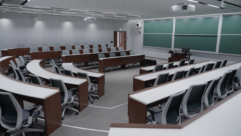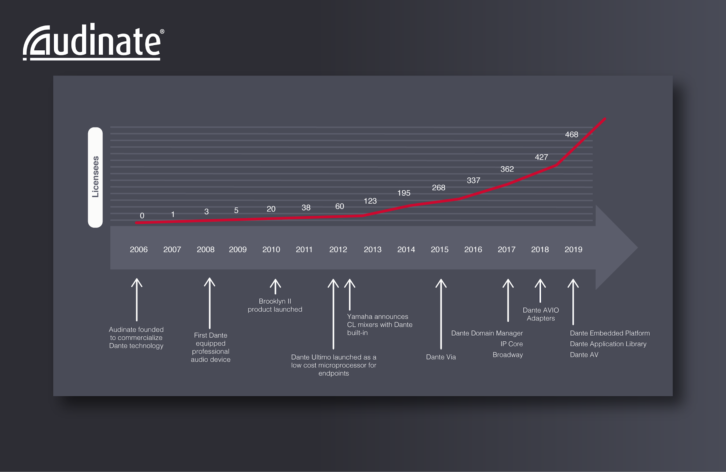
This year will always mark a turning point for Audinate. It’s clear the company has gone big on change and expansion— the debut of Dante AV and Dante-as-Software, and the accompanying partnerships, start a course for Dante that will encompass video distribution, embedded software, alongside the continued expansion of the Audinate control platform. This year will also see CEO Lee Ellison retire this month after 11 successful years and an IPO.
Founder Aidan Williams will move from his long tenure as CTO into CEO role as a yearlong planned transition and a natural extension of all the other plans for the company’s signature networking platform. When the announcement was made in May, Williams said he saw his role “as leading the team to unlock the value embedded in transforming the global AV industry through networking and software.” Grand plan indeed.
It takes confidence and commitment to roll the impeccable Dante reputation to a wider play, with all the attendant risks. Can Audinate who—with industry partners like Yamaha—shepherded and midwifed audio into the networked age do the same for video? Can the company also make the modern leap from hardware-enabled networking (which will continue) to being an embedded software as well?
Williams isn’t worried. From his viewpoint Audinate was always a software company. Even though hardware was how the revolution would begin, software was in the DNA, part of the plan from the very beginning. Now he says, with his own long experience in AV and as a computer-enabled musician, he’s seen first-hand the growing speed and power of processors; software is at an inflection point for our industry he says. “Hardware doesn’t go away,” he says, “there will always be hardware endpoints and in the near-term hardware will still serve large channel counts. But there is a wider opportunity.
“The way I think about the software side of things is that from the very beginning at Audinate we viewed the networking technology as related to general IT technology. Networking, computers, software all go together in my mind at least.
“We began with hardware and software. One of the initial things—Dante Virtual Sound Card—was a pure software implementation of Dante from the very beginning. That blew people’s mind. No plugin PCI card.”
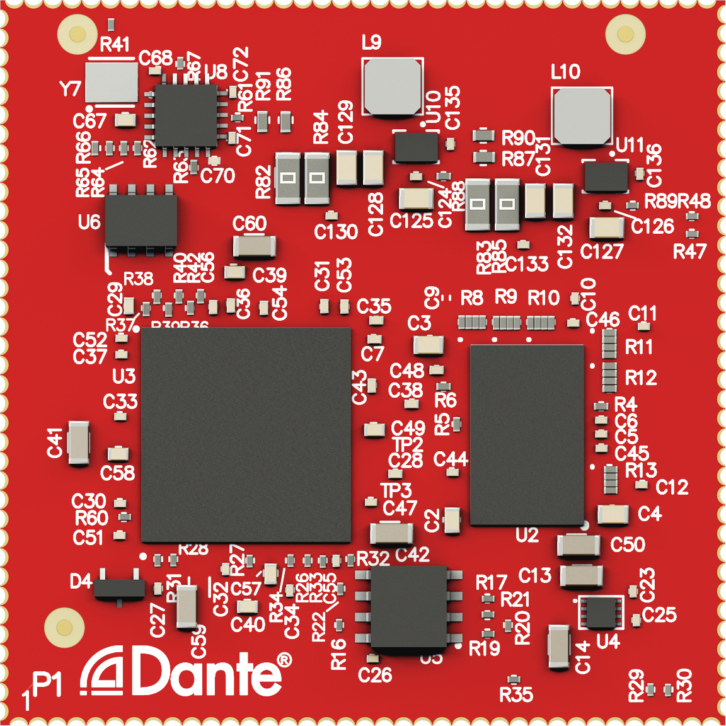 He sees the latest developments as continuity. And he explains this is an organic evolution driven by the industry itself. It’s not just Audinate; the expanding power of IT is moving us from purpose-built hardware to software-based solutions running on standardized hardware.
He sees the latest developments as continuity. And he explains this is an organic evolution driven by the industry itself. It’s not just Audinate; the expanding power of IT is moving us from purpose-built hardware to software-based solutions running on standardized hardware.
“We have heard for years that customers wanted to have video over IP offered alongside Dante audio over IP; we first demonstrated Dante for video all the way back in 2011. So we’ve had years of experience talking to customers—manufacturers, integrators and end customers—to understand their requirements and fold that into the specifications for Dante AV. We are confident that we’ve developed a product that hits the sweet spot of providing a superior video experience that will deliver for almost every installed AV use case, while still operating over a 1Gbps network to make it usable in the real world with existing infrastructure.”
As for his new job as CEO which starts this month?
“For me this has been a process. In my role as the founder and chief technology officer, I’ve had substantial input into the company and what we make since the very beginning. For me the exciting aspect of stepping into the CEO role is to take more ownership of the strategic direction and drive that through. Growing, making it more widely available, allowing the industry to capitalize on the technology, which I think is a credible and achievable goal.
“There’s also a realization of increased responsibility for other parts of the business. What gives me a great deal of comfort in that area is we’ve done a good job in building out the executive leadership team, sales, HR—I’ve been handed a good foundation. I’m grateful for Lee and the board putting in an excellent team I get to inherit.”
With all this in mind let’s recap some of the highlights of Audinate’s 2019 so far.
Dante and 10G
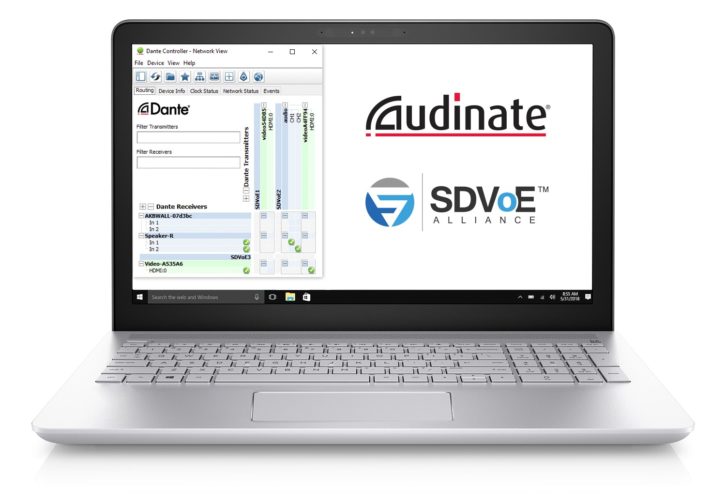 The 1G-focused Dante AV hit in January; that same month saw Dante audio bridging to 10G through a newsworthy partnership with SDVoE first implemented in a new class of products from IDK. This new class of product links Dante audio for the first time with the SDVoE ecosystem.
The 1G-focused Dante AV hit in January; that same month saw Dante audio bridging to 10G through a newsworthy partnership with SDVoE first implemented in a new class of products from IDK. This new class of product links Dante audio for the first time with the SDVoE ecosystem.
The IDK IP-NINJAR/Dante Audio Bridge (model: NJR-AB08DAN) transcodes audio signals directly between the SDVoE and Dante protocol environments. Audio signal transport is enabled from NJR transmitters to Dante devices and from Dante device to NJR receivers. The bridge eliminates third party converters and processors. Each NJR-AB08DAN can receive up to four audio streams from IP-NINJAR transmitters outputting up to eight channels in Dante protocol. Additionally, each bridge can accept up to 8-channel audio from Dante sources, outputting IPNINJAR (SDVoE) protocol in up to four audio streams. This feature enables Dante audio embedding on HDMI signals and de-embedding through analog audio outputs at IP-NINJAR receivers.
The partnership between the SDVoE Alliance and Audinate expanded further in June when Audinate joined the Alliance as a contributing member and announced further collaboration plans. InfoComm saw demonstrations of Dante Controller managing SDVoE signal routing in the SDVoE Alliance booth and the Audinate booth.
Dante AV
In January, just before ISE, Audinate announced Dante AV, an integrated audio and video-over-IP solution for manufacturers. At InfoComm, Yamaha announced they’d take up the offer, followed a month later by telco/networking company Patton Electronics.
Audinate describes Dante AV as a complete integrated audio and video networking solution and promises to bring to video the same style of discovery, ease of use and integrated control that made Dante transformative for audio. Audinate says that Dante AV enables complete interoperability with every Dante-enabled audio product already on the market, which this year crossed the milestone of 2000 products. They comprise the largest installed base of AV Over IP devices in the world.
Dante is an IP routable Layer 3 technology that allows you to use standard IT network switches and cabling that are readily available.
One goal is to solve networked video and audio synchronization, utilizing a single network clock for sub-microsecond accuracy. With Dante AV, audio and video signals are independently routable in a single, interface using the Dante Controller software. One example: Dante AV solves time alignment issues and eliminates the need for audio de-embedders in applications such as sports bars, live events and multi-zoned AV systems for lip sync everywhere.
The Dante AV Module supports one video channel and eight bidirectional channels of uncompressed Dante audio. The Dante AV Module is ideal for manufacturers creating 1G video-over-IP products and includes Dante control, transport and synchronization. The architecture is codec-agnostic. In alignment with the software ethos, Dante AV also comes with an API so manufacturers can customize their management user interface.
Audinate has made the Dante AV Module available with the Dante AV Product Design Suite, providing a complete AV-over-IP endpoint design kit for manufacturers to get product to market. The Product Design Suite incorporates the Dante AV Module and includes hardware documents and software to create complete, fully interoperable AV products. The Dante AV Product Design Suite includes a JPEG2000 codec supporting 4K/60 4:4:4 video for visually lossless results with low latency over a 1Gbps network. Dante AV Product Design Suite also implements HDCP (High-bandwidth Digital Content Protection) to prevent copying of digital audio & video content as it travels across connections. The Dante AV Product Suite can be easily customized to suit an OEM’s specific requirements and provide competitive differentiation.
At InfoComm, Yamaha announced that it had adopted Audinate’s Dante AV Product Design Suite and would pursue integrated AV over IP audio/video technology. Yamaha’s product team has begun concrete studies for a suite of new products targeted for the Pro AV market. Initial Yamaha AV products will center around applications requiring the need to breakout and distribute audio and video signals, while maintaining tight synchronization throughout the facility or venue.
Yamaha and Audinate have been collaborating for nearly a decade. Yamaha first supported the Dante audio network technology with the Mini-YGDAI card “DANTE-MY16-AUD” released in 2010. In 2012, Dante interfaces became a standard installed feature on CL Series digital mixing consoles. Yamaha has subsequently introduced a number of Dante-compatible products, such as the RIVAGE PM series of flagship digital mixing systems, the MTX / MRX series of matrix processors, and the VXL series of PoE line array speakers.
“The collaboration with Audinate over the past 10 years has been extremely beneficial to Yamaha,” stated Yoshi Tsugawa, Senior General Manager of Yamaha Audio Business Division in a press release at the time. “Taking advantage of Audinate’s expertise in digital networking has transformed networked audio and we anticipate Dante AV will deliver the same benefits for networked video in the Pro AV industry.”
“Yamaha has a reputation for being very conservative and thorough in their analysis of new technology,” Williams says, “so when they backed Dante audio in the early days, it added a level of credibility that the technology was solid,” Williams adds. “For Dante AV, it’s exciting that Yamaha is again an early supporter of the technology.
“When we envisioned Dante AV, we saw two potential segments of customers,” Williams continues. “The first were manufacturers who were already using Dante for audio, and were looking to branch out into video. The second were manufacturers who were already making (or thinking about making) networked video products and were looking to add Dante audio capabilities. Having Yamaha voice their support for Dante AV is great validation of the first segment being viable, and there are many more interested customers beyond Yamaha in both segments that we are actively engaged with.” (He declined to name names at this time. I asked).
In July, Audinate announced commercial availability of Dante AV; Patton Electronics, a US manufacturer and OEM/ODM supplier of networking and connectivity solutions for Pro-AV and Telephony, including VoIP, announced that they would adopt the platform into a new generation of AV-Over-IP products.
In a press release at the time, Buddy Oliver, VP of Business Development for Patton touted the relationship: “Patton brought on the FiberPlex (aka LightViper) brand in 2017. Patton’s VoIP expertise combined with FiberPlex’s AV experience makes the addition of video a natural next step. We are excited to introduce video capable UC products to our existing markets as well as gaining access to new adjacent markets.
Dante-As-Software
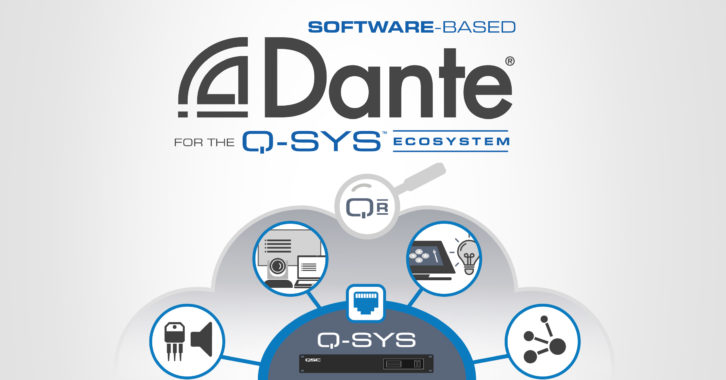 About a week before InfoComm, Audinate announced two new software-based Dante products. Dante Embedded Platform enables manufacturers to add full Dante functionality in software running on Linux for x86 and ARM processors. The Dante Application Library allows software developers to seamlessly integrate Dante functionality directly into their PC and Mac applications.
About a week before InfoComm, Audinate announced two new software-based Dante products. Dante Embedded Platform enables manufacturers to add full Dante functionality in software running on Linux for x86 and ARM processors. The Dante Application Library allows software developers to seamlessly integrate Dante functionality directly into their PC and Mac applications.
These new software-based solutions give manufacturers and developers the ability to deploy Dante into products and applications where it wasn’t previously feasible, in ways that weren’t previously possible with purpose-built hardware. Specifically, Dante can now be deployed in products where either the price point or form factor made integrating dedicated Dante hardware challenging. Dante as software also provides the potential to enable new capabilities like Dante being deployed retroactively to products already in the field, the ability to add new features and functions to products on the fly, and the possibility for manufacturers, integrators or customers to configure the number of Dante channels they want for a particular application.
The Dante Embedded Platform drafts off the fact that leading manufacturers are already delivering AV products built on powerful commodity x86 and ARM computing hardware running Linux. In a press release, Audinate reminded the industry that Dante Embedded Platform “is designed for these OEMs, providing cost-effective Dante networking with minimal additional hardware.”
Dante Embedded Platform will offer two options for manufacturers: an SDK with validation tools will eliminate costly guesswork by allowing OEMs to easily qualify existing x86 and ARM based products for Dante performance requirements. For new products under development, Audinate will also provide complete reference designs for popular ARM SoC chipsets such as the Analog Devices ADSP-SC589 and NXP i.MX 8M Mini QuadLite.
QSC and Audinate had previously announced a strategic partnership. At InfoComm came word that QSC would begin to deploy the Dante Embedded Platform within the Q-SYS ecosystem to enable native software-based Dante audio channels without the need for additional I/O or external configuration software. With this development, integrators will be able to add Dante audio natively as an extension of the Q-SYS integrated audio/video/control workflow. It also makes device discovery, synch, control and management for Dante available directly within Q-SYS Designer (or still via Dante Controller if desired).
QSC says all new Q-SYS Core processors will ship with a small set of Dante audio channels at no extra cost. Additionally, QSC will offer tiered feature licenses to enable Q-SYS system users to scale Dante integration capabilities based on their specific installation needs and Q-SYS Core processor capabilities.
For Analog Devices (ADI), Audinate announced a reference design for ADI’s popular ADSP-SC589 DSP + ARM processor. Audinte also announced at the time they had become a member of the Analog Devices Alliances program.
The Dante Embedded Platform Reference Design Kit for ADSP-SC589 enables OEMs to design high performance, software-based Dante products for that processor. Quoting the press release: “The ADSP-SC589 SoC pairs two powerful SHARC DSP cores with an ARM Cortex CPU and allows developers to focus on their own algorithm and UI development on a software-based platform with a highly optimized software and tools ecosystem.”
Last month, Audinate also announced they had collaborated with NXP Semiconductors’ for a reference design kit for NXP’s i.MX 8M processors, enabling on-chip software. The Dante Embedded Platform Reference Design Kit for NXP’s i.MX 8M processors will be validated by Audinate for Dante performance, and lets OEMs design for Dante with confidence. The i.MX 8M Mini QuadLite processor offers four Cortex-A53 cores, one Cortex-M4 core with flexible memory options and a variety of high-speed connectivity interfaces, ideal for AV-over-IP applications.
The Dante Application Library for Windows and MacOS gives developers the ability to build Dante functionality directly into their products. Each instance is wholly contained within each application and not shared with other resources, allowing multiple Dante-enabled applications to run simultaneously on a single computer with complete independence.
With Dante Application Library, developers can integrate Dante device discovery and subscriptions directly into their conferencing, recording, lecture capture and media playback products for a seamless “one-stop-shop” setup experience. It provides instant access to thousands of popular Dante-enabled products that include microphones, DSPs, amplifiers and powered speakers. One of the head-turning partnerships announced at InfoComm was with Zoom, which has teamed with Audinate to integrate the Dante Application Library into its Zoom Rooms application for video meetings.
For more information, visit the Dante Embedded Platform and Dante Application Library product pages.





